Typical variants of florariums
Before reading the instructions for beginners on how to make a florarium with your own hands, it is worth learning more about typical ecostructures, because for various reasons, not all plants can comfortably coexist with each other.
Desert
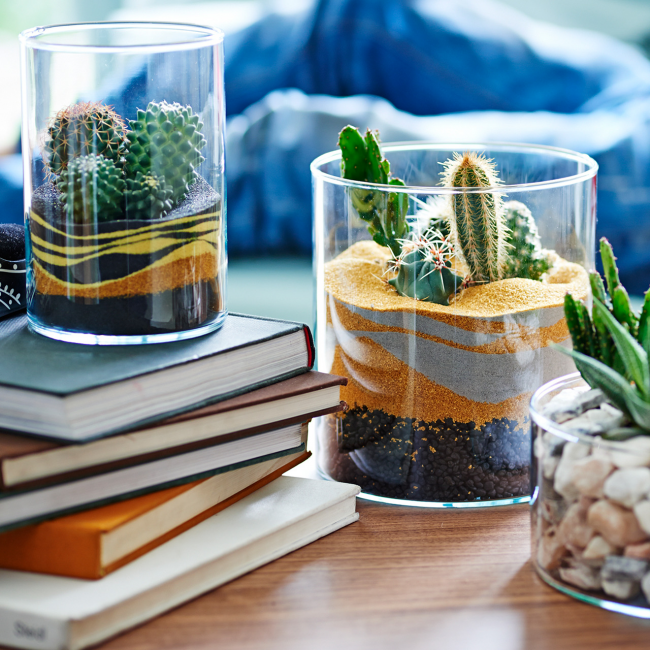
Mandatory attributes of the desert are, of course, cacti. Colored sand will complement the composition of the desert florarium, which will set the atmosphere
This florarium will simulate a desert. Succulents grow well in it, which include:
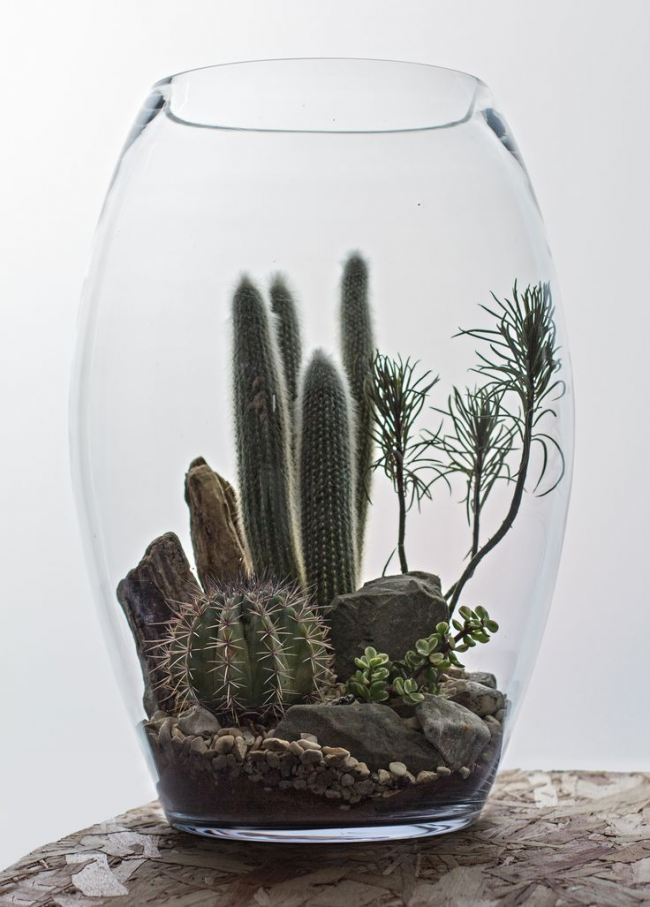
Do-it-yourself atmospheric composition of the desert in the florarium
Soil - sand with a layer of at least 10 cm, it must be well sieved. You can supplement the picture of the desert with large stones, a piece of sandstone. This option is suitable for those who do not have time to care for, water, control the microclimate. Watering such compositions is necessary as the soil dries up, several times a week are quite enough. The temperature is not critical for them, even if it drops below +15 degrees, but they need the sun, so it is better to place such a florarium on the windowsill.
This florarium will require more strength and attention. First of all, the soil - it has a complex composition. It includes: leafy soil, peat, coarse sand. All this must be thoroughly mixed. As a decor, you can use driftwood, willow roots (they must first be boiled in water), tree bark. A characteristic feature of this type of composition is the filling of the central part of the container with plants.

It is not always possible to be closer to nature, and this is especially problematic for people living in big cities, and even with a busy work schedule. Florarium, modeling a piece of forest, will dilute the routine of gray everyday life
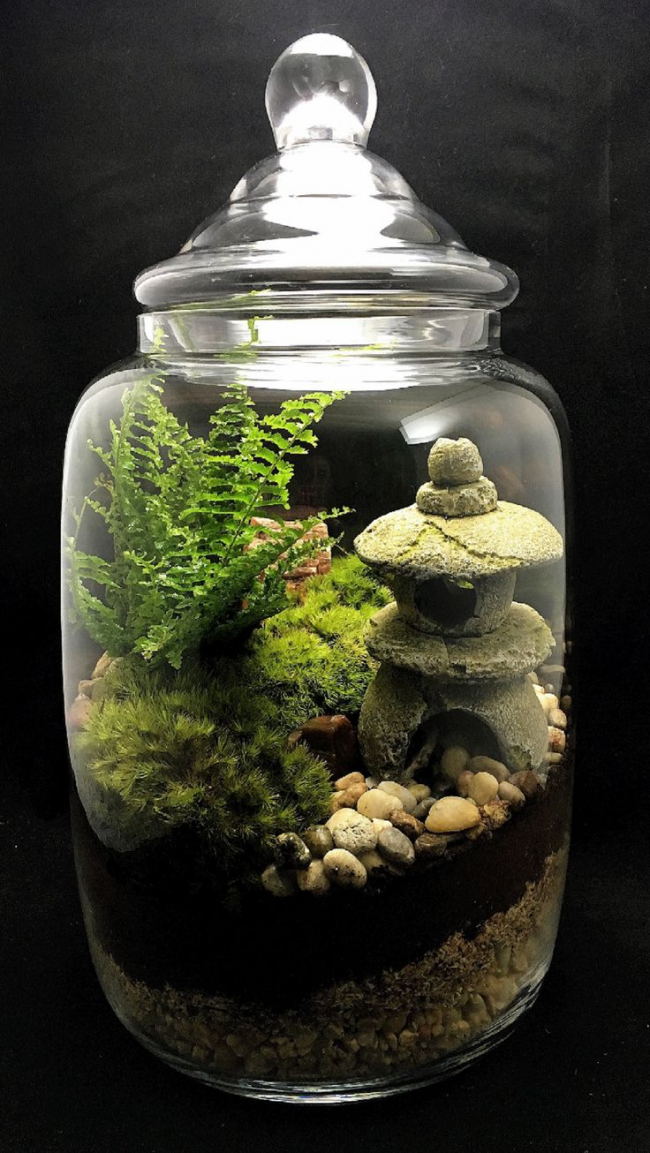
Florarium with a lid will help keep moisture inside, preventing it from quickly evaporating
To do this, you need to put a drinker or a bath inside. It also needs to be ventilated regularly. Often they are based on tropical rainforests. The main requirement is a combination of plants according to soil requirements. And you don't need to look for some special outlandish plants, the simplest ones will do.

For florariums modeling the compositions of mountains, it is worth picking up stones of a relatively large size
This is an imitation of mountain landscapes and, of course, vegetation. It needs to be made quite narrow, but high. The soil is sand and large pebbles. The soil should be oily and rich in organic matter. Different plants can be used:
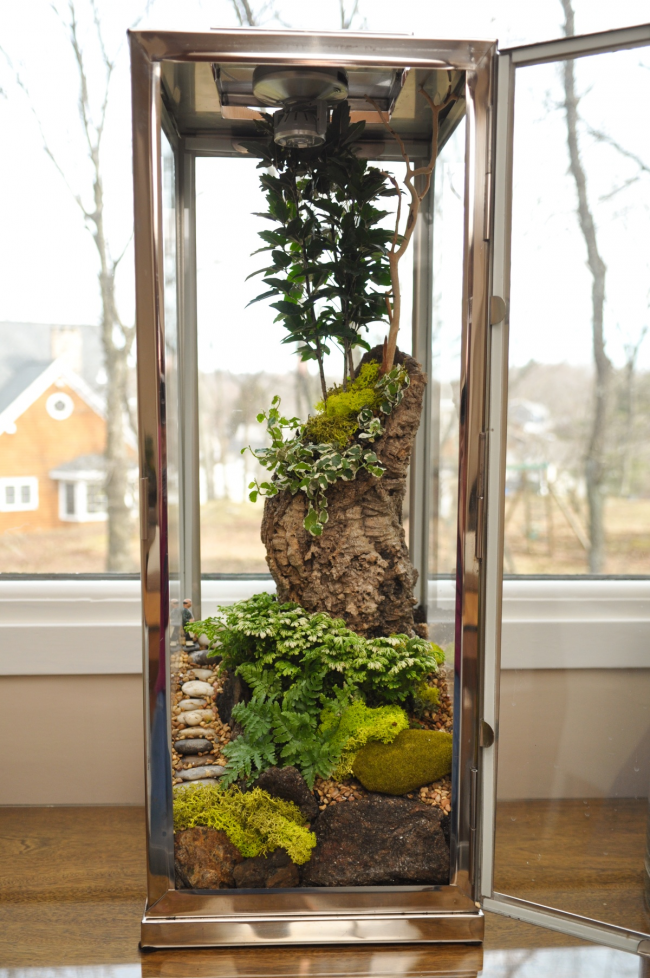
Atmospheric florarium imitating mountainous terrain
Plants need to be watered, so drinkers should be provided. You can actively use stones of irregular shape, with sharp edges - they may well imitate rock ledges and mountain peaks.
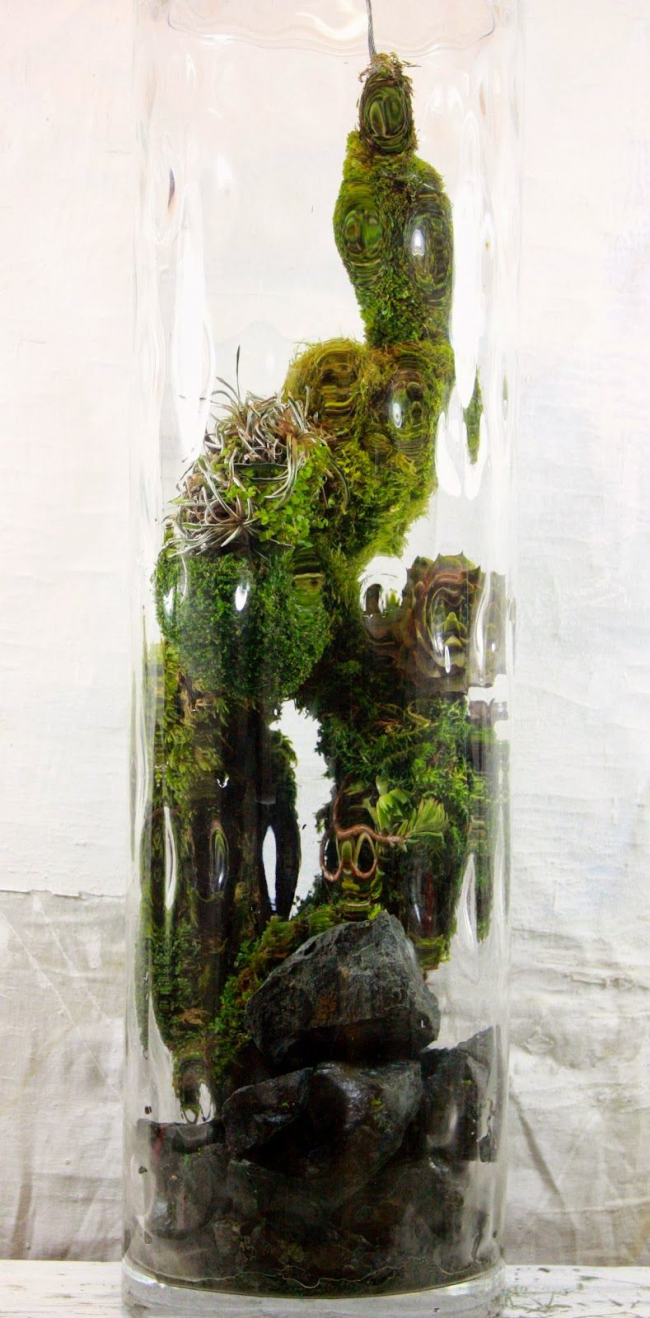
Don't be afraid to experiment! To decorate a mountain in a vertical florarium, an unusual branch overgrown with moss is quite suitable
Such a florarium with your own hands can be made according to the instructions (see video), and it will not be difficult. Indeed, there are more than 10 thousand species of such plants in the world, and they grow in almost all climatic zones. They do not make purely moss compositions; they are often supplemented with other elements. Before placing the plant in a container, you need to cut off the upper part without the rhizome to allow it to build up the root mass on its own.
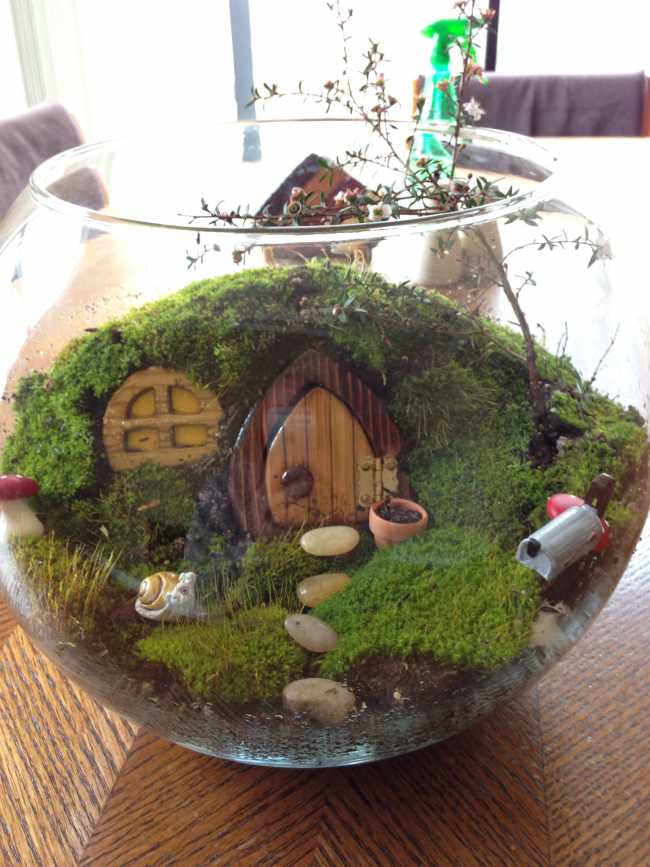
Cute florarium with a decorated composition of a moss house of a fairy forest hero
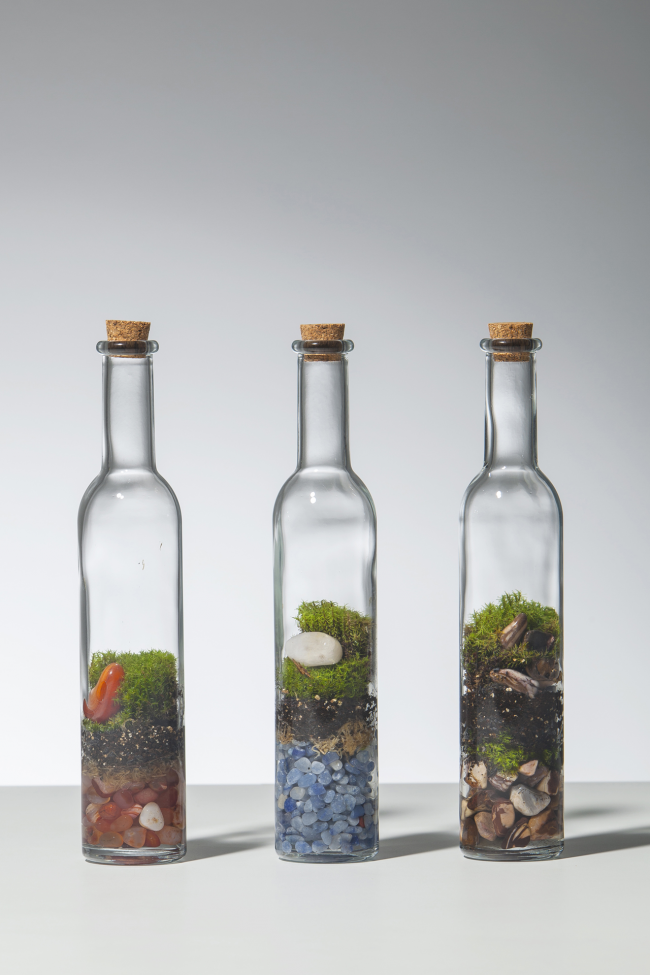
Florariums with moss compositions in glass bottles
Master class on filling the florarium from the florist - Alexander Matyukha
Recently, it has become very popular to plant succulents and cacti in glass vases - florariums. Now you can easily purchase a variety of geometric containers in online stores, and even florariums with ready-made compositions. There is also a more economical option - to find a suitable glass vessel at home and fill it to your liking and desire. Succulents grow well in florariums, this is due to the plant's protection from drafts and temperature changes.

Especially for our readers, we have prepared a master class from Alexander Matyukha. Alexander is a botany teacher and creator of beautiful florariums in combination. A very laborious process, to make a whole work of art out of glass and alloys! Alexander has his own workshop, where he is engaged in the manufacture and filling of glass vases. He kindly shared with us the secrets of filling florariums at home.
And so, for your own purposes, you can use the purchased vase, or find something suitable at home, in size and shape, and read about what to do next in our article:
Materials for creating a mini-garden at home

Drainage for florarium
To create a home greenhouse under glass, you will need the following materials and tools:
- Soil (soil) - is selected depending on what type of plant will be planted. A layer of peat and fine sand is laid out for succulents and cacti in a ratio of 2: 1, vermiculite, earth and perlite are poured in equal parts to moisture-loving crops. To maintain the required level of soil acidity, flour is added. Another way to prepare soil mixture is to buy ready-made soil from a flower shop, which is ideal for each type of green inhabitants of the garden display case.
- Drainage - the drainage layer is made up of expanded clay, coarse sand, broken brick, activated carbon, decorative small stones or pebbles
- Decor - small pebbles, colored sand, driftwood, twigs, figurines, houses, shells and more are suitable as decorative elements. It all depends on fantasy
- Working tools - tweezers, a syringe or a special watering bottle, a set of garden mini-tools or a spatula, gloves, skewers to secure the decoration, a wine stopper to tamp the soil, scissors
Optional equipment

An interesting idea for creating a backlight for a mini garden
- Hygrometer and thermometer. Devices needed to monitor the level of humidity and temperature in the container in order to provide the green inhabitants of the florarium with the most similar living conditions. As a rule, tropical species crops need high temperature and humidity, so a thermometer and hygrometer will provide control of these indicators.
- Backlight. Installed as additional lighting. To diffuse and soften bright light, use only opaque shades. If the light from the greenhouse is too bright and intrusive, or interferes with sleep at night, the glass of the container is tinted. This gives an interesting effect to the showcase and solves the problem.
- Fan. Due to the closed space, the plants need to create constant air circulation, then the inside of the container will be fresh and clean. During the installation of the ventilation system, it is worth considering the volume of the showcase with the garden
- Automatic watering. Optional device. However, with its help, there will be no need to constantly worry about the required level of air humidity and it will become easier to take care of garden dwellers.
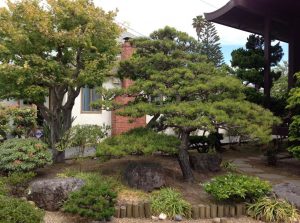
Pine in the yard: secrets of growth, folk signs, tricks of planting in the open ground and caring for it (55+ Photos & Videos) + Reviews
What is florarium
An amazing and colorful mini-garden in the aquarium first appeared in the shop windows of the 18th century, and adorned the salons of titled ladies.The idea belonged to Nathaniel Ward - a naturalist researcher first guessed to plant capricious tropical flowers inside a colorless container, where a suitable microclimate was created for the green beauties. Today mini-gardens in the aquarium are gaining popularity again, becoming a decoration of houses, apartments, offices and shops. Since many flowers from southern countries require special conditions, creating a suitable microclimate in the container will allow you to enjoy the riot of rich colors of tropical guests.
A florarium in an aquarium is a composition with flowers for which greenhouse conditions are specially created. In fact, florariums are ordinary reservoirs, only instead of a space with fish and water, the viewer will see colorful plants, pebbles and sand.
You can buy a garden in an aquarium in stores, but buying this decorative element will cost the buyer a tidy sum. Plant lovers prefer to build florariums with their own hands, creating a real little miracle. Before you learn how to make a miniature garden with your own hands, you need to study what types of greenery are suitable for a florarium.
Types and devices
Depending on the type of container, the shape of the planted plants, miniature greenhouses behind glass are divided into several types. From a botanical point of view, the florarium can only be closed with limited air access from the room. Such products create the most favorable atmosphere for whimsical plants, optimal humidity and temperature. There are also dry sand gardens that do not require watering.

Florariums with open access to plants are more common. The ecosystem in a glass or aquarium is also individual, but concentrates on the bottom of the container. These can be single plants or a whole group. You can make single-tiered, multi-tiered compositions.
What capacity is suitable
They create living accessories from the most unusual glass objects. They differ in geometric shape, size, decorative elements. Depending on the type of container, the following natural greenhouses will be obtained:
- Aquariums. Suitable containers of any shape (round, square), open, closed type. You can plant a variety of plants, use any decorative drainage;
- Bottled. They are created from any vessels with a narrow neck and large capacity. Plants are planted in such a container, which do not differ in rapid development. It is difficult to give a craft a beautiful appearance. Great for woody greenery.
- Wall mounted. The products are distinguished by the possibility of being hung on the wall. They are much smaller than the floor ones. Can be closed and open;
- Mini florariums. For the manufacture of compositions, small glass attributes are used: transparent Christmas tree decorations, cups, glasses, vases. Plants must also be miniature. Succulents, mini-violets, ivy and others will do.
Plants - recommendations for selection
For decorative bottle gardens, low greenery with slow growth is suitable. If a composition is created from different types, then the tallest specimen is placed in the center, the middle ones are planted around it. The smallest are located at the edges. Plants growing in the same container must have the same care requirements, be matched in color and texture. You can collect them yourself in the forest, planting, buy in a specialized store. The following types are most suitable for a flower terrarium:
Mosses and ferns. Feel great in humid environments. Sphagnum in the florarium is used to fill space. This type of moss ranges in color from whitish to deep green. They mask pots, wrap snags. Fern use nephrolepis. A bunch of feathery leaves looks beautiful as a separate plant or a background for a composition, it requires frequent thinning, since it grows quickly.
Beautifully flowering plants. An orchid is recognized as the most beautiful for a garden behind glass.To grow a whimsical plant, a florarium of a special design is required, equipped with heating and ventilation systems. Saintpaulias (dwarf violets) grow surrounded by velvet leaves. You can also plant hybrids of cyclamens, gusmania, azalea, but provided they are stabilized with glycerin.
With unusual leaves. One of the most popular plants for the florarium is Fittonia. All of its leaves have pink or white streaks. Only suitable for open aquariums. Crotons are decorated with golden spots on the leaf plate. The greenery of alocasia is elongated, has a pointed shape.
For dry greenhouses. In such an environment, cacti and other types of succulents are usually grown. Plants are able to exist for a long time on their own moisture reserves. Special desert landscapes are created for them.
Pay attention to echinopsis, rebutia, prickly pear, fatty varieties.

Soil for florarium
The soil should be chosen based on the needs of the plant. It is better for novice florists to take ready-made mixtures and substrates. For self-preparation of universal soil, it is necessary to mix it with sand in a ratio of 1: 1. For succulents and cacti, a lighter soil is needed, two parts should be added to the sand.
Since there are no drainage holes in the florarium, artificial soil openers are simply necessary. Pebbles are laid out at the bottom of the container, covered with moss or a piece of burlap and covered with a layer of charcoal. For undemanding plants, land can be taken from a vegetable garden or forest. It must be disinfected, since a humid environment is favorable for the development of mold and mildew.

How to do it yourself?
You can buy ready-made or look at home and adapt what is available - cans, glasses, bottles, teapots and vases. Ready-made florariums can be found in almost any shape - cube, sphere, hemisphere, cone, cylinder, dome, but the most popular are geometric florariums.
For tropical florariums and orchidariums, containers with a small hole, in which high air humidity is created, are more suitable.
For succulents, use containers with a wider mouth, as they prefer low humidity levels.
Drainage
Florariums are very beautiful, where multi-colored colored sand is used as a drainage layer.
Unfortunately, the sand tends to mix during watering, so in this case the plants are trying to be planted in the center of the container and watered very carefully. This extends the decorative effect of the puff pastry for longer.
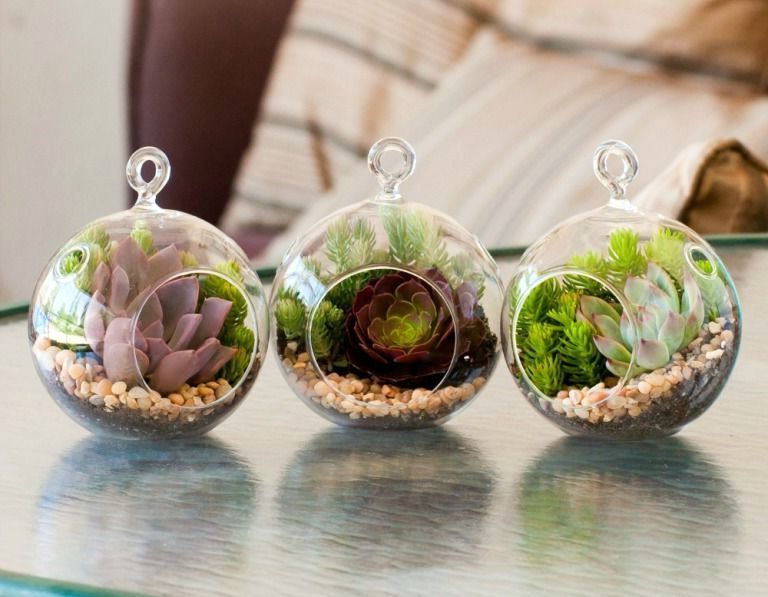
It is better not to overdo it with fertilizers, use half doses. Plants that quickly set off in growth will spoil the appearance of the florarium.
A florarium of succulents will be mastered even by a beginner who has never kept indoor plants before, but the creation of a rainforest will require a more serious approach and some knowledge.
Mosses. The most commonly used species are sphagnum or mosses of various types, which can be found at a pet store or aquarist department. They can only be used in tropical florariums.
Colored glass.
Natural materials: twigs, driftwood, dried flowers. Their use gives the composition a natural feel.
Decorative figurines. They allow you to create a special atmosphere, "play" some small plot.
When creating a florarium with your own hands, it is important to strictly follow a certain algorithm. It is not enough to plant plants correctly, because such a masterpiece includes many subtleties.
We offer you a master class in the form of step-by-step instructions on creating a garden in glass.
Decide on an idea. Each creation should be liked by its creator. Therefore, choose exactly the style of florarium that you like.
Choose a location. Much depends on where the terrarium with plants will stand. The future vessel must be selected taking into account the parameters of this place.
Purchase and prepare a vessel.Choose a ready-made florarium in the store or find a suitable container at home. Before planting plants, you must thoroughly wash their future home and wipe the inside with alcohol. This will kill all pathogenic bacteria, as well as get rid of fingerprints, which will be highly visible.
Pick up plants and test them for compatibility. A rapidly growing Kalanchoe will conflict with cacti, which develop almost imperceptibly. It is better to choose those succulents and plants that have a similar growth rate and susceptibility to environmental conditions.
Purchase the necessary soil, drainage and decorations
Soil is the most important thing for the well-being of future residents of the florarium
Therefore, at the moment, you should pay close attention. Decorations will complement any garden and make it unique.
Prepare the table and place everything you need on it
For the successful creation of a florarium, you must be convenient and comfortable.
And for this you need to place all the elements so that you can reach them with your hand. Remove the plants from the pots and rinse their root systems under warm water.
Put on gloves. Fingerprints inside the florarium after planting the plants will be almost impossible to wipe off, and they will spoil the appearance quite strongly.
Add soil and other ingredients. At the bottom, lay a layer of sand about 1 cm, then expanded clay with charcoal of the same thickness. Choose a soil layer depending on the longest root system. The plant should sit comfortably in the soil so that all roots are completely covered with soil.
Make holes for the plants and plant them. They should not overlap each other with leaves. Consider this, as they will still grow. After making the holes at the optimal distance, start planting succulents, being careful not to damage the roots. The leaves and shoots of plants should also not touch the walls of their new home.
It's time to decorate. After planting all the plants, arrange all the planned elements: decorative sand, stones, ceramic figures.
Water the plants and close the lid. Lightly moisten the soil near each plant. Cover the florarium with a lid, if provided by the design.
For information on how to make a florarium with your own hands, see the next video.
Rules for drawing up a florarium
Before you start working with plants, a little interesting theory. The florarium can be of two types: dry and wet.
- in a dry florarium, it is forbidden to use moss for decoration. Any. Neither stabilized nor alive. Moss absorbs all moisture and retains it for a long time. For succulents that do not like a humid environment, this is detrimental. If you see moss in the florarium with succulents, never buy anything in this store! Non-professionals work there and they can only harm the plants. And don't do it yourself.
- choose the right combination of plants. Succulents and cacti are only suitable for a dry florarium, and orchids and ferns are suitable for a wet one. Do not scoff at plants and do not put succulents in one florarium that do not need a lot of water together with tropical ferns that live in 98 percent humidity.
- select the right dishes for each type of florarium. Open forms of glass florariums are well ventilated and that is why it will be ideal for dry florariums. But a bottle with a narrow neck is well suited for a humid florarium, since that very humid environment will be created there.
Popular compositions
Glass gardening is true creativity at its best. Currently, both a mixture of styles and individual categories of florariums are popular. Let's consider the main ones.
Desert theme. A composition of small cacti will decorate a small windowsill or office interior. The style basis here is sand, which can be combined with stones and pebbles. They will look beautiful and rejuvenated.
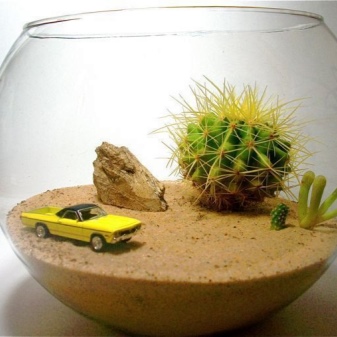
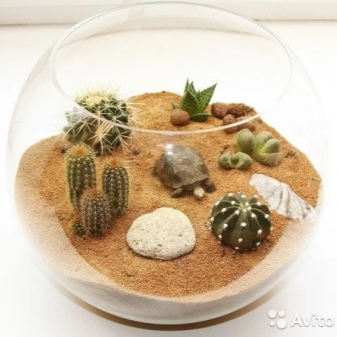

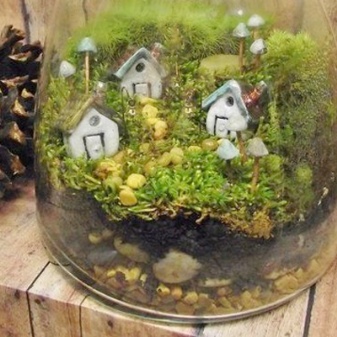

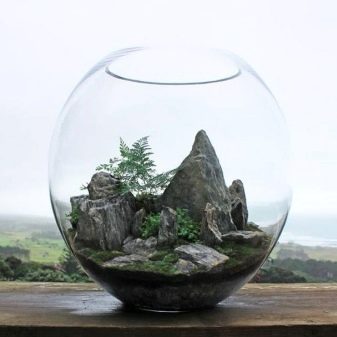
Ceramic garden figurines of the smallest sizes are often added to florariums. They look appropriate with the dark greenery of a garden in a bottle and slightly dilute the cold composition.
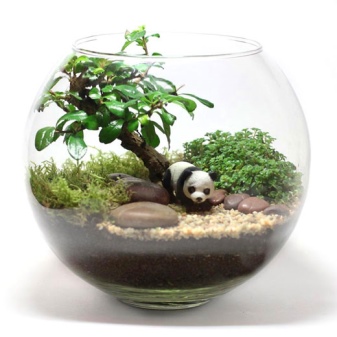
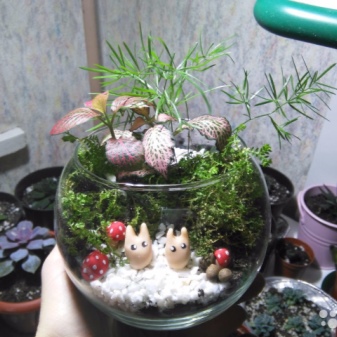
Plant selection
Succulents that are suitable for the florarium are very diverse both in appearance and in their structure. Their choice depends on the taste and preference of the manufacturer. The recommended list includes such plants.
Cacti. These desert dwellers in a closed transparent container, together with other plants, look just wonderful. Their greenery and thorns begin to play with new colors, and the appearance of the florarium becomes elegant and stylistic. Cacti grow slowly, live well in conditions of rare watering, which makes them simply irreplaceable inhabitants of a vegetable terrarium.
Spiky and smooth, blotchy and bright green - all this variety can be embodied in the plant terrarium. Plants of more than one type can be included in the composition. Allocasia, fetonia, mosses and mini ferns will work well with succulents.
When choosing compositions, they carefully study not only the decorative characteristics, but also the preferences of plants for the soil, the requirements for lighting, humidity and care: all the parameters of the “neighbors” in the florarium must match.
The main rule when choosing a plant is that it should be dwarf and have a very slow growth rate.
- Ferns: maidenhair, or hair venus; asplenium; mnogoryadnik; pteris;
- trees: ficus microcarpa, mirsina, Japanese maple, pomegranate, etc.;
- tillandsia, now very popular tillandsia from the atmospheric group, are used for planting together with succulents, while the rest of the species are more suitable for tropical florariums;
- orchids: miniature phalaenopsis, phalaenopsis and Kinga dendrobium hybrids, ludisia, papiopedilums;
- ivy, varieties with small leaves and low growth rate);
- hypocyrt;
- hypoesthesia;
- fittonia;
- cryptantus, or earth star;
- sawing;
- selaginella;
- saltium (for ground cover in large florariums).
Suitable for planting:
- adenium;
- echeveria (echeveria) and her relatives;
- slipway;
- aloe: miniature species like a. aristat or a. brindle;
- gasteria;
- Haworthia;
- live stones, or lithops;
- small cacti: astrophytums, hymnocalycium, mammillaria, etc.);
- aichrizon (can be formed in the form of a tree);
- fat woman;
- aeonium (small specimens).
Succulents for the garden in a jar
Succulents are most popular when creating florariums, and for good reason. Usually they are easy to care for, are small in size, do not grow too quickly, and at the same time look exotic and different. Moreover, even one type of succulents can differ significantly in appearance, be of different shapes and have different colors of "leaves", different flowers, etc. Just keep in mind that they do not like high humidity, so when choosing a vase, choose with a wide neck. And one more thing: it will be necessary to water them very rarely, and so that not the entire layer of soil / sand gets wet. It will be necessary to make a thick drainage layer, and use coarse sand with the addition of soil as soil.
Try to make the first florarium from succulents and cacti
Haworthia
Does not bloom, but has decorative lancet leaves. Undemanding to temperature and humidity conditions. Can be used in combination with more demanding plants. He does not like wet soil too much and can rot from moisture entering the sockets.
Easy Care Haworthia succulents
Aptenia
A flowering plant, flowers are small, bright pink, lilac, white. Leaves are fleshy, small. It is not too demanding for growing conditions, tolerates both high and low humidity.
Aptenia (Aptenia) can be successfully grown in a vase
Monanthes
There is Monanthes in the form of a very small bush, and there is a grassy one.Can create dense cushion curtains. Stems are erect with a deciduous rosette at the top. Some species are in bloom. It is not too demanding for temperature, does not like high humidity, but needs good lighting. A dormant period with a decrease in temperature in the winter is desirable.
Small plants are suitable for the smallest florariums
Piaranthus
It has a very unusual shape - creeping stems, consist of segments. Each of the segments has several "teeth"
In combination with an unusual color - various shades of green and brownish-green, star-shaped flowers - this plant will attract attention. Can be the center of the composition
Requirements for care are low, it should be protected from direct sunlight only in summer.
Unusual bright flowers and strange stems
Argyroderma
The very unusual shape of the plant in combination with the silvery shade of the leaves gave rise to their popular name - living stones. In shape, the leaves resemble small pebbles (usually no more than 2 cm), from which a large and bright flower grows. The conditions are generally undemanding.
Blooming stones are an interesting addition to a glass garden
Conophytum (Conophytum)
This type of succulent plant is also called live rock. The leaf shapes are even stranger and more unusual. Flowers are very similar to daisies - bright and large. They have a clear growing season and rest. Vegetation is usually in winter, rest in summer months.
The leaf shapes are the most unusual. And these plants live on Earth?
Echeveria
This type of succulent is also called a stone rose. Care is simple, only the leaves are better not to touch with your hands. They are covered with the finest coating that wears off when touched. But since the florarium is almost a closed container, the probability of plaque damage is small. Another feature is that a rest period with a temperature of about 15 ° C is required.
Stone rose is not so unusual, but looks great on rocks and sand
Lithops
Lithops also look like stones that have suddenly bloomed. They differ in that they can change the color of the leaves to match the color of the soil. They grow very well on stony soil, withstand high temperatures. They are similar in care to cacti, so they can be combined. They grow slowly and require bright light for normal development.
Another plants from another world
These are not all succulents and there are still no less interesting ones, but even these are enough to create a couple of thousand of the most different compositions.
How to make a florarium with your own hands?
To make your own florarium, you will need:
Transparent container, glass or plastic
You can buy ready-made or look at home and adapt what is available - cans, glasses, bottles, teapots and vases. Ready-made florariums can be found in almost any shape - cube, sphere, hemisphere, cone, cylinder, dome, but the most popular are geometric florariums.
For tropical florariums and orchidariums, containers with a small hole, in which high air humidity is created, are more suitable.
For succulents, use containers with a wider mouth, as they prefer low humidity levels.

Drainage
Expanded clay (with a fraction of less than 5 mm), pebbles or sand. Its layer should be more than in an ordinary pot, not less than 4 cm. In ready-made closed florariums, a double bottom is often used, which allows you to remove excess water.
Florariums are very beautiful, where multi-colored colored sand is used as a drainage layer.
Unfortunately, the sand tends to mix during watering, so in this case the plants are trying to be planted in the center of the container and watered very carefully. This extends the decorative effect of the puff pastry for longer.
Plant substrate
Succulents will need a light sand mixture, orchids - a special soil based on tree bark, the rest will use a regular ready-made soil with the addition of perlite and vermiculite (30% of the total amount of soil).
It is better not to overdo it with fertilizers, use half doses. Plants that quickly set off in growth will spoil the appearance of the florarium.

Plants for florarium
A florarium of succulents will be mastered even by a beginner who has never kept indoor plants before, but the creation of a rainforest will require a more serious approach and some knowledge.
Decorative elements
Mosses. The most commonly used species are sphagnum or mosses of various types, which can be found at a pet store or aquarist department. They can only be used in tropical florariums.
Colored glass.
Stones, shells.
Natural materials: twigs, driftwood, dried flowers. Their use gives the composition a natural feel.
Decorative figurines. They allow you to create a special atmosphere, "play" some small plot.
Master class, step-by-step instructions with a photo:

- What do we need to fill the florarium?
- Plants, substrate and drainage are required to fill the florarium. Read which succulents are best for you. Usually succulents are planted, or vice versa, moisture-loving plants. For the latter, florariums with a lid are more suitable, inside which the optimal air humidity will be constantly maintained. It is also worth considering that such plants need a larger capacity than succulents, and the substrate must be sufficiently nutritious.
For succulents, florariums of various sizes and volumes are suitable, since they grow rather slowly and feel great on poor substrates - sand and gravel.
Due to their unpretentiousness, succulents are more popular, therefore, using their example, it is worth talking about planting plants in the florarium.
An extremely important component of the florarium is drainage. It sounds proudly for sealed containers, but the problem of stagnant water must be solved. This can be done using various hygroscopic materials; fine expanded clay and hydrogel can be used. It is also necessary to use activated carbon, which is used in filter columns and filters for aquariums. Coal for a long time does not allow the walls of the florarium to "bloom" - to develop algae.
- Which substrate is suitable?
- As already mentioned, gravel and sand-gravel crops are perfect for growing succulents. Both sand and gravel can be purchased at the store, or collected with your own hands on the seashore (especially when it is nearby)
The collected material must necessarily undergo processing, it is best to ignite it in an old unnecessary frying pan or baking sheet in the oven. Purchased materials are easy to rinse.
Purchased materials can be painted and unpainted, quarried or otherwise - for every taste.
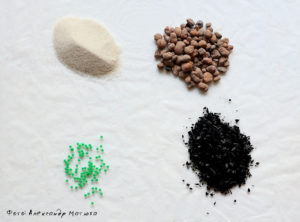 Substrate for filling the florarium - sand, drainage, hydrogel, activated carbon
Substrate for filling the florarium - sand, drainage, hydrogel, activated carbon  Colored pebbles, pebbles and gravel
Colored pebbles, pebbles and gravel  Shells for decoration
Shells for decoration
- Small cacti, haworthia, echeveria, lithops, sedum and crassula perfectly coexist in glass.
- How to properly plant a plant in a glass vase?
- Planting is carried out in several stages:
First you need to thoroughly wipe and polish the vase itself using a glass cleaner. If we are talking about the florarium, made in the Tiffany technique, then take care of the platinum at the seams, try not to chip or scratch it.
- Before planting, prepare everything you need: remove the plants from technical pots and rinse the roots in warm water, select the substrate in accordance with your plan - everything should be at hand.
- First, it is necessary to pour a sand cushion on the bottom (so that coarse gravel and expanded clay does not leave deep scratches on the bottom edge). Place expanded clay in the center, add hydrogel and activated carbon.Lay out the side edges with gravel. Place the plants in the resulting "bowl" and cover the gaps with gravel.
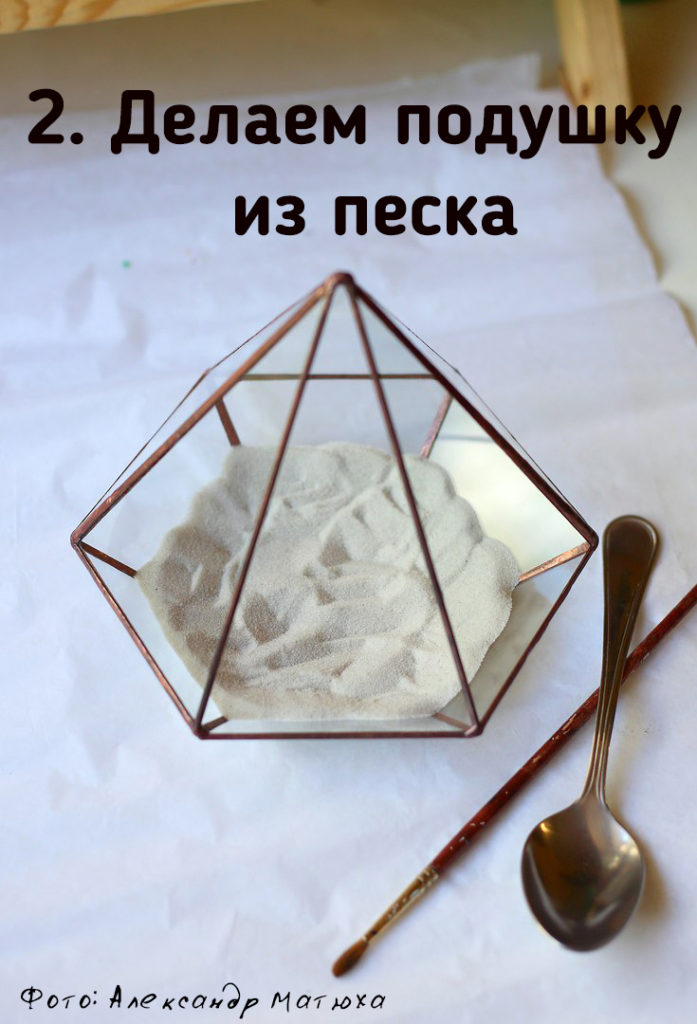
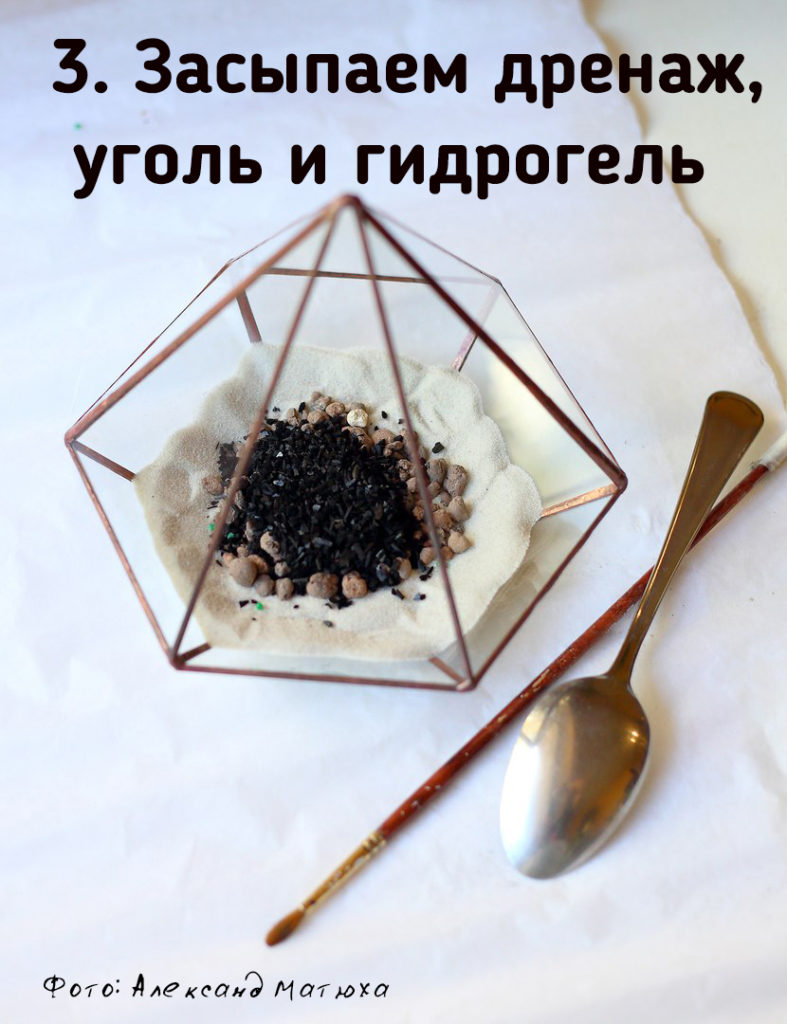
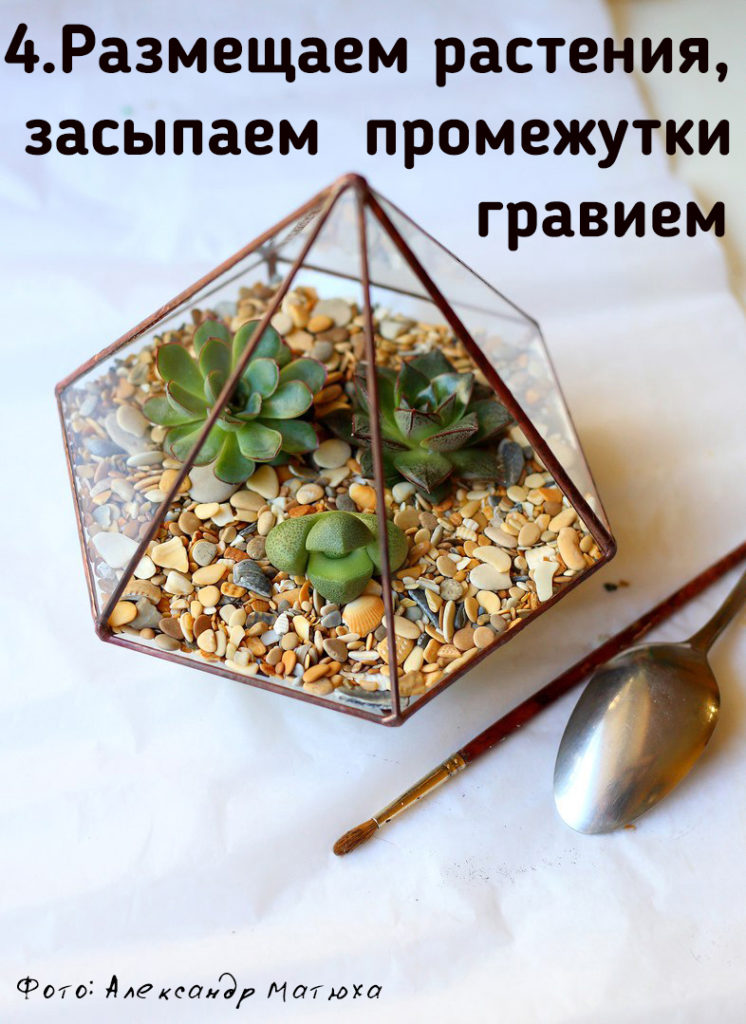
- How can a florarium be decorated?
“Everyone has different tastes, I prefer natural, natural materials in natural colors and shades. Sometimes customers turn to me who want to design a vase in a certain color scheme. Such experiments also turn out to be very interesting. "
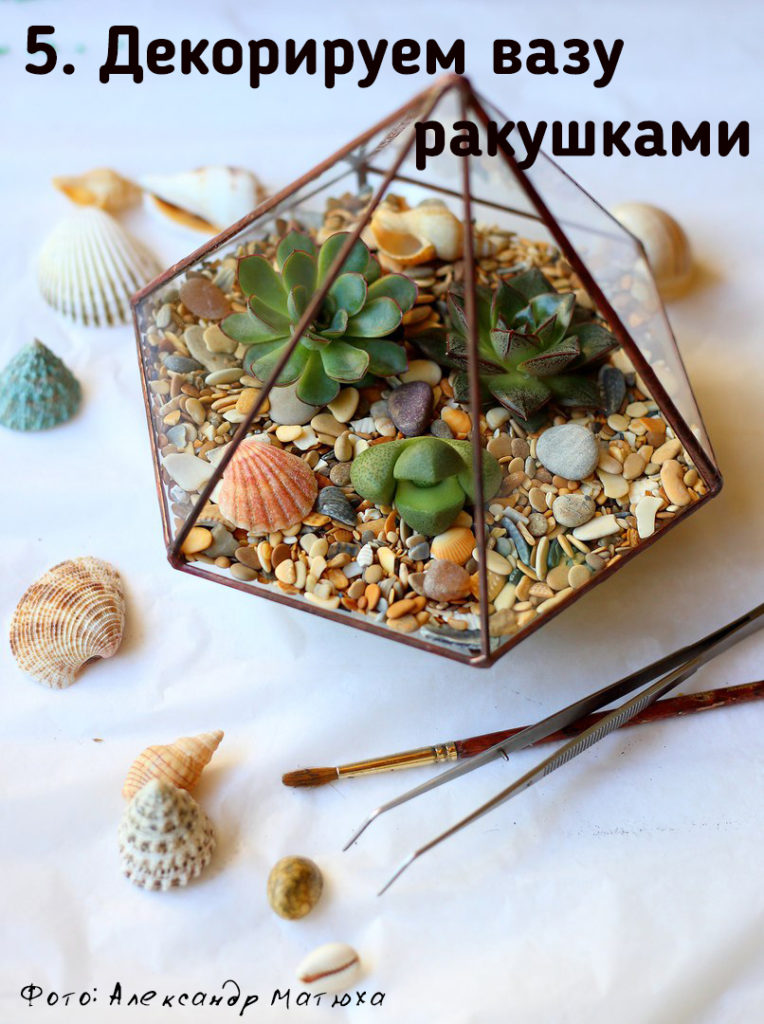
- Recommendations for plant care in the florarium
- It is not difficult to take care of plants in the florarium:
- For succulents, light is important, infrequent feeding and so that the water does not stagnate. Therefore, watering is carried out every two to three weeks (depending on the room temperature) until the sand cushion is wetted.
- Fertilizer for cactus and succulent plants is sold in flower shops and specialized sections of supermarkets. Be sure to check the expiration date and shake the bottle well before use.
- If the plant has grown, and the roots are visible on the lower edges, carefully remove it from the florarium and transplant it into a pot or large florarium - everything is here, just like with any other indoor plant.
Here we have such beauty in the end!


